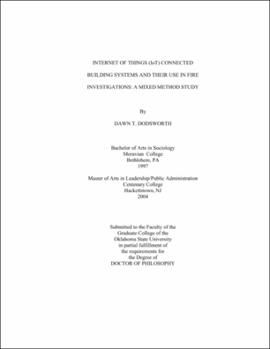| dc.contributor.advisor | Frucci, John | |
| dc.contributor.author | Dodsworth, Dawn T. | |
| dc.date.accessioned | 2022-05-13T15:26:35Z | |
| dc.date.available | 2022-05-13T15:26:35Z | |
| dc.date.issued | 2021-12 | |
| dc.identifier.uri | https://hdl.handle.net/11244/335747 | |
| dc.description.abstract | In 2009 the National Academy of Sciences produced a paper entitled Strengthening Forensic Science in the United States: A Path Forward. The purpose was to identify significant improvements needed in forensic science. The paper provided recommendations involving policy initiatives that should be adopted by various forensic science disciplines to increase their effectiveness. One of the fields included was fire investigation. Experts, such as Professor Jonathan Koehler from Northwestern University, have inferred that forensic science fields relying heavily on subjective interpretation of data tend to be the most problematic. | |
| dc.description.abstract | John Lentini and John DeHaan, recognized fire investigation experts, have stated that the accurate interpretation of fire effects and fire patterns can lead an investigator to the proper area of origin within a fire scene. However, the accurate interpretation of these patterns can be challenging. The correct interpretation of these patterns is dependent upon numerous variables, including the knowledge, training, and experience of the investigator as well as the investigator's understanding of scientific theory related to such topics as fire science, fire chemistry, thermodynamics, and fire dynamics. Occasionally fire investigators can misinterpret observed patterns. This can result in misidentifying the area of origin. | |
| dc.description.abstract | The Internet of Things (IoT) is a system of interrelated computing devices; these can be both mechanical and digital machines embedded with sensors, software, and other technologies that connect and exchange data with other devices and systems over the internet. Several building systems potentially fall into the category of IoT due to how they typically function such as fire sprinklers, fire and smoke detection systems, and security systems. As a result, data from the IoT involving these systems can be extracted, analyzed, and subsequently employed by fire investigators to narrow down the area of fire origin within complex fire scenes. | |
| dc.description.abstract | This study focuses on the utilization of IoT data to make fire investigations more empirical by decreasing the necessity for substantial reliance on the subjective interpretation of fire patterns. The creation of hard data points in the determination of an area of origin will successfully address the issues enumerated by Lentini, DeHaan, Koehler, and the National Academy of Sciences. | |
| dc.format | application/pdf | |
| dc.language | en_US | |
| dc.rights | Copyright is held by the author who has granted the Oklahoma State University Library the non-exclusive right to share this material in its institutional repository. Contact Digital Library Services at lib-dls@okstate.edu or 405-744-9161 for the permission policy on the use, reproduction or distribution of this material. | |
| dc.title | Internet of Things (IoT) connected building systems and their use in fire investigations: A mixed method study | |
| dc.contributor.committeeMember | Agnew, Robert | |
| dc.contributor.committeeMember | Green, Matthew | |
| dc.contributor.committeeMember | Hess, James | |
| dc.contributor.committeeMember | Webb, Scena | |
| osu.filename | Dodsworth_okstate_0664D_17395.pdf | |
| osu.accesstype | Open Access | |
| dc.type.genre | Dissertation | |
| dc.type.material | Text | |
| dc.subject.keywords | building systems | |
| dc.subject.keywords | fire investigation | |
| dc.subject.keywords | internet of things | |
| dc.subject.keywords | methodology | |
| thesis.degree.discipline | Forensic Science | |
| thesis.degree.grantor | Oklahoma State University | |
